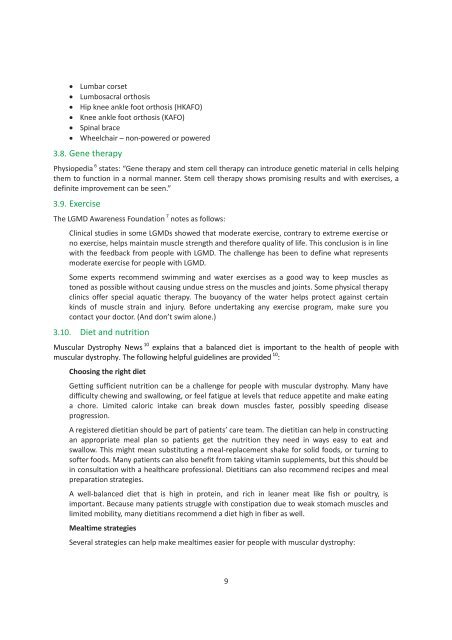Create successful ePaper yourself
Turn your PDF publications into a flip-book with our unique Google optimized e-Paper software.
Lumbar corset<br />
Lumbosacral orthosis<br />
Hip knee ankle foot orthosis (HKAFO)<br />
Knee ankle foot orthosis (KAFO)<br />
Spinal brace<br />
Wheelchair – non-powered or powered<br />
3.8. Gene therapy<br />
Physiopedia 6 states: “Gene therapy and stem cell therapy can introduce genetic material in cells helping<br />
them to function in a normal manner. Stem cell therapy shows promising results and with exercises, a<br />
definite improvement can be seen.”<br />
3.9. Exercise<br />
The <strong>LGMD</strong> Awareness Foundation 7 notes as follows:<br />
Clinical studies in some <strong>LGMD</strong>s showed that moderate exercise, contrary to extreme exercise or<br />
no exercise, helps maintain muscle strength and therefore quality of life. This conclusion is in line<br />
with the feedback from people with <strong>LGMD</strong>. The challenge has been to define what represents<br />
moderate exercise for people with <strong>LGMD</strong>.<br />
Some experts recommend swimming and water exercises as a good way to keep muscles as<br />
toned as possible without causing undue stress on the muscles and joints. Some physical therapy<br />
clinics offer special aquatic therapy. The buoyancy of the water helps protect against certain<br />
kinds of muscle strain and injury. Before undertaking any exercise program, make sure you<br />
contact your doctor. (And don’t swim alone.)<br />
3.10. Diet and nutrition<br />
Muscular Dystrophy News 10 explains that a balanced diet is important to the health of people with<br />
muscular dystrophy. The following helpful guidelines are provided 10 :<br />
Choosing the right diet<br />
Getting sufficient nutrition can be a challenge for people with muscular dystrophy. Many have<br />
difficulty chewing and swallowing, or feel fatigue at levels that reduce appetite and make eating<br />
a chore. Limited caloric intake can break down muscles faster, possibly speeding disease<br />
progression.<br />
A registered dietitian should be part of patients’ care team. The dietitian can help in constructing<br />
an appropriate meal plan so patients get the nutrition they need in ways easy to eat and<br />
swallow. This might mean substituting a meal-replacement shake for solid foods, or turning to<br />
softer foods. Many patients can also benefit from taking vitamin supplements, but this should be<br />
in consultation with a healthcare professional. Dietitians can also recommend recipes and meal<br />
preparation strategies.<br />
A well-balanced diet that is high in protein, and rich in leaner meat like fish or poultry, is<br />
important. Because many patients struggle with constipation due to weak stomach muscles and<br />
limited mobility, many dietitians recommend a diet high in fiber as well.<br />
Mealtime strategies<br />
Several strategies can help make mealtimes easier for people with muscular dystrophy:<br />
9

















